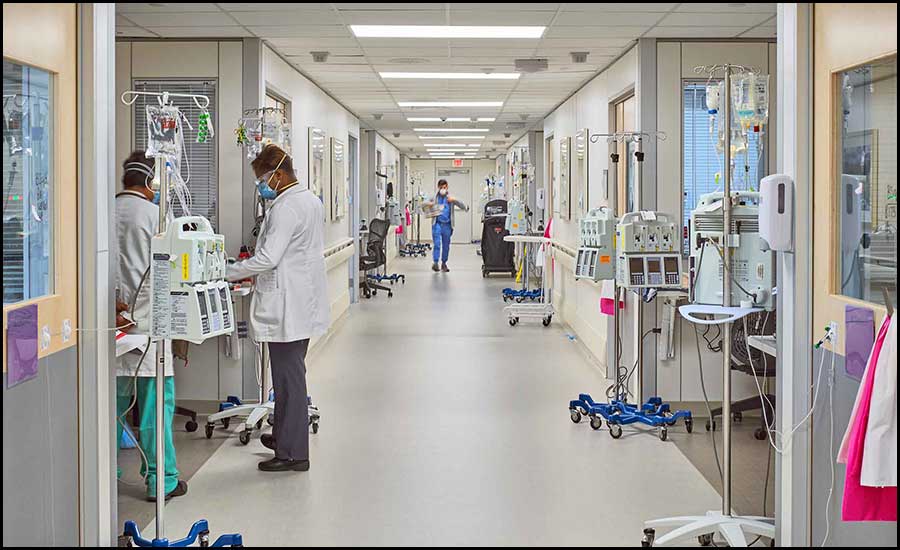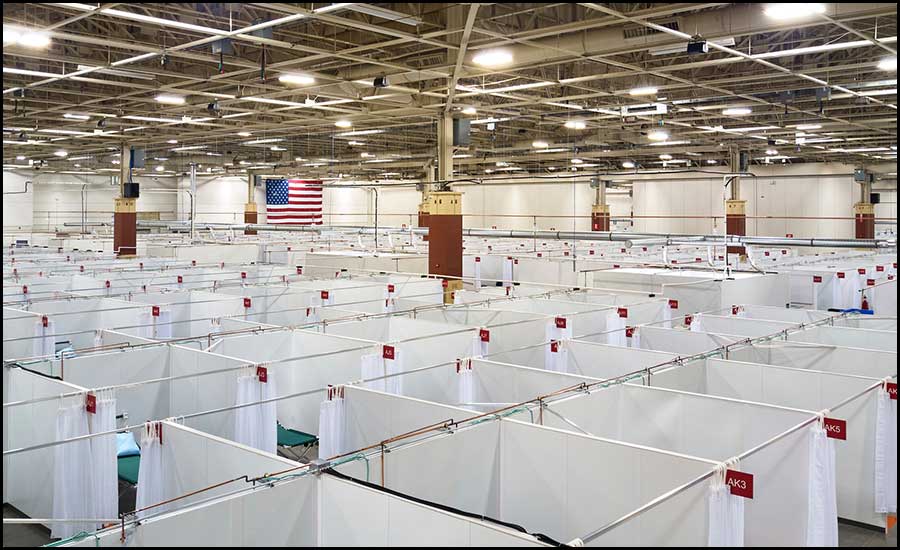It’s a well-known maxim that any project hoping for speed, quality, and affordability can only realistically hope to accomplish two of these goals — people call the trio an “unattainable triangle.” In a traditional health care construction project, it is often the case that meeting the rigorous standards essential for medical safety either pushes the budget or stretches the timeline for a new building. Recent innovations in prefabricated modular construction have the potential to upend these assumptions and allow the delivery of patient care units for hospitals and clinics that are engineered to the highest safety and efficiency specifications but simplified enough in manufacturing and assembly to enable rapid delivery at a reasonable cost.
Expanding familiarity with design for manufacturing and assembly (DFMA) is prompting many clients to embrace prefabricated modular components for projects, enabling them to rapidly expand capacity while using economies of scale to keep costs in check and standardized production to ensure consistent quality. In a health care setting, where bed capacity limits the number of patients a facility can treat, the extended timelines of traditional building projects are very costly — both to the health of desperate patients in need of care and in lost revenue from patient procedures that cannot be performed without adequate space. When an expanding regional population or a unique health threat increases local demands for care, these institutions are motivated to expand their available beds as quickly as possible to meet the community’s needs.
In the early days of the COVID-19 pandemic, HGA, a national multidisciplinary design and engineering firm, collaborated with its longtime partner in building and prefabrication, The Boldt Company, to develop a system of modular hospital units that could be built at a manufacturing site and deployed to a location with astonishing speed while still meeting rigorous safety and efficiency standards. The resulting system was called STAAT Mod (Strategic, Temporary, Acuity-Adaptable Treatment – Modular on Demand), and the first installation of the system — adding 16 private intensive care unit (ICU) airborne infection isolation rooms (AIIR) with the staff and utility areas to support them at Adventist HealthCare Fort Washington Medical Center in Maryland.
STAAT Mod modules are aimed at higher acuity patients and engineered to meet The U.S. Centers for Disease Control and Prevention (CDC) guidelines for airborne infection control for patients undergoing aerosol-generating procedures. Instead of merely housing patients during a crisis, STAAT Mod is designed to provide all the resources necessary to treat and heal the gravely ill while protecting the essential workers who care for them.
Foremost in its design are protections to keep patients and health care workers safe and to facilitate best practices for treatment. With access to equipment and integrated systems that greatly exceed most rapid-delivery health care solutions, STAAT Mods are designed for staff efficiency in monitoring and treating the critically ill while also providing room to don and doff personal protective equipment (PPE), safely transfer patients, and improve recovery outcomes by leaving space for recliners where patients can sit upright and see the sky outside their windows. Systems integrated into headwalls provide access to ventilators, cardiac and vital sign monitors, and gases for respiratory treatment.
Highly engineered HVAC systems use HEPA-filtered closed loops with 100 cfm of exhaust per room to create true AIIRs that prevent viral spread while negative pressure protects staff in adjacent work areas. IT connections and nurse call systems are integrated into patient and staff spaces.
These modules are also built with remarkable flexibility for adaptation to unique site requirements. Units are equipped with plumbing fixtures that can either be connected to local systems or drained into holding tanks for periodic removal. Power can be seamlessly transferred between normal utility service and on-site generators. Though initially intended to merely increase treatment capacity for the growing number of COVID-19 patients, these STAAT Mod units are acuity-adaptable, so they can be adjusted for traditional inpatient or more demanding ICU care, depending on a hospital’s needs.
"When you enter the unit, it feels like a new hospital wing; it’s a seamless addition to our existing structure,” said Said Griffin L. Davis, vice president and chief medical officer at Adventist HealthCare Fort Washington Medical Center. “The amazing thing for us was that we quadrupled our ICU space in two months. The modular ICU has quality construction and state-of-the art technology and quality. It represents the future of health care construction, and I’m glad we have it."
In the months since the first STAAT Mod units came into use, several other institutions have adopted the system to increase their patient care capacity. At Northside Gwinnett Hospital in Georgia, STAAT Mod units were used to build a 46,983-square-foot facility with 71 beds designed for varying levels of care. Targeted to meet COVID-19 needs and then be transitioned to accommodate other uses, Northside’s STAAT Mod building is part of the hospital’s strategic expansion plan to meet the health care needs of Atlanta’s growing population. The construction team was able to undertake the full site preparation, while the requisite STAAT Mod units were being fabricated in the warehouse, facilitating rapid project completion — from design to operation in only four months — a process that would normally take nearly two years.
Now, STAAT Mods can provide a solution for health systems to deliver portable, community-based medicine. The evolving design has everything needed to provide high-quality health environments that improve access and equity of care for under-served communities.
 FIGURE 1 Northside Hospital Gwinnett unveiled STAAT Mod units in December 2020 to care for up to 71 COVID-19 and critically ill patients. Image courtesy of Thomas Watkins Photography.
FIGURE 1 Northside Hospital Gwinnett unveiled STAAT Mod units in December 2020 to care for up to 71 COVID-19 and critically ill patients. Image courtesy of Thomas Watkins Photography.
The contractors working on these and other installations have quickly come to appreciate the benefits of prefabricated modular construction even beyond accelerated timelines. Since much of the technical work is done in assembly-line fashion in the warehouse, local contractors are not limited by shortages of skilled subcontractors near the job site — a particular benefit as many construction teams suffered staffing difficulties due to illness or quarantine requirements during the pandemic. Working indoors in large warehouses, construction teams are spared interruptions due to adverse weather and can accelerate intensive tasks by having crews work illuminated by warehouse lights after the sun is down.
“Being able to perform sensitive tasks in controlled settings also increases job site safety, since it decreases the need for scaffolding, transporting specialized equipment, and maneuvering in tight spaces,” said Will Lichtig, chief of staff and executive vice president for performance and innovation at The Boldt Co. “As more contractors become familiar with the installation process for these systems, they are also developing the experience to complete projects faster and more efficiently. This will lead to further reductions in cost.”
The ability of any prefabricated modular components to achieve these goals of speed, quality, and affordability depends primarily on the rigor of the design, engineering, and manufacturing that creates them. One of the reasons HGA was able to accelerate delivery of STAAT Mod was that the firm already has collaborative structures in place between its in-house design and engineering staff and longstanding relationships with its fabrication and trade partners. Using building modeling software, we were able to coordinate solutions that met code and construction standards while also achieving design goals based on clients’ needs. Precious time was saved by having engineering input in the plans and feedback from trade partners from the very beginning of the process, averting time-consuming changes later. Working together, the team was able to create a single set of shop drawings that included both the design and construction specifications for the fabricators and contractors to work from.
The possibilities for incorporating prefabricated modular construction solutions include much more than one system. Not every project is well-suited to a full building composed of STAAT Mod modules. Some lend themselves to prefabrication of some repeated components, like patient rooms, within an existing structure or as part of a larger, traditionally constructed project. Other buildings may only choose to use prefabricated elements, like standardized mechanical, electrical, and plumbing (MEP) racks, for ease of installation.
While the STAAT Mod was responding to one need during the pandemic, the U.S. Army Corps. of Engineers undertook the creation of an alternative care facility to handle overflow patients from local hospitals at Wisconsin’s State Fair Park Exposition Center in Milwaukee. The goal was to use the large indoor exposition center in lieu of creating an independent facility to treat these patients on a very urgent timeline. They assembled a team to design and construct treatment areas for 530 non-acute COVID-19 patients, each in a 10-by-10-foot “room” formed from three, 8-foot-tall hard walls with a curtain for the fourth wall and an open ceiling so it could utilize existing exposition center lighting.
 FIGURE 2 HGA, Gilbane Building Company, USACE, FEMA, and others provided emergency response expertise in the renovation of Wisconsin’s State Fair Park Exposition Center. Image courtesy of HGA
FIGURE 2 HGA, Gilbane Building Company, USACE, FEMA, and others provided emergency response expertise in the renovation of Wisconsin’s State Fair Park Exposition Center. Image courtesy of HGA
These modules were arranged within three of the center’s halls using a scalable design that included piped and bottled oxygen for specific areas according to patient acuity, modifications to electrical power to ensure 100% backup using emergency generators, a plumbing system for toilet rooms in the middle of the expo space, and a wireless nurse call system. The MEP racks designed for these rooms were the first such system to gain approval for use by the U.S. Department of Health. The state fair park care facility was designed for operational efficiency in delivering the best possible patient outcomes while acknowledging this was a temporary installation. The transformation of the building for medical care was designed and executed on a stunning 10-day timeline.
Prefabricated systems are as well-designed as the standards that guide them. It is much more efficient to design modules for institutions that have already determined their requirements for treatment rooms, mechanical systems, and staff spaces than it is for those who have not yet articulated these needs. Given the technical nature of the various local and national codes that apply to health care spaces and constantly evolving medical best practices, it is vital that the design and engineering teams are fully up to date with industry trends and any impending changes in regulations.
Designing prefabricated units for use across jurisdictions, HGA strives to meet the highest level of code standards so that our units can be adopted without needing modification for local codes.
For Advocate Aurora Health in Wisconsin and Illinois, investing in their design standards has allowed HGA as a design partner to push the envelope of prefabrication.
“By relying on comprehensive design standards and using prefabrication, we’re able to save time in the design process and ensure each new facility meets requirements from safety to infection control to patient experience and also achieve our top-tier sustainability goals,” said Karen McKenzie, director of planning, design, and construction for Greater Milwaukee and South Wisconsin at Advocate Aurora.
For its ongoing expansion of Aurora Medical Center in Grafton, Advocate Aurora used established standards to design and construct a modular expansion that will quickly provide much-need capacity for the growing hospital. The use of prefabrication also helped reduce construction time and waste, further aligning with Advocate Aurora’s commitment to sustainability.
Advocate Aurora is also using prefabricated modular solutions for parts of two new hospitals they are building. This innovative approach is only possible when there is collaboration from the beginning between general contractors, designers, and fabricators to ensure effective planning and execution. Questions about laying out the spaces and integrating systems need to be approached from the outset and simplified so that the same elements can be repeated throughout the design for efficiency.
For several health systems HGA is working with, investing in design standards allows architects and engineers to push the envelope of prefabrication. As HGA’s clients prepare to move forward with each innovative step in the modular and prefab movement, their teams rely on comprehensive standards they have already developed for clinical consistency and quality control. This saves time in the design process and ensures that each new facility meets requirements while also allowing innovation specific to site needs.
Prefabricated solutions are not easily reverse-engineered — it would be very difficult to design a hospital along traditional lines and then ask a contractor to prefabricate its components for construction. Instead, the questions about laying out the spaces and integrating their systems need to be approached from the outset and simplified so that the same elements can be repeated throughout the design for efficiency. For this reason, prefabricated modular systems also do not lend themselves to traditional design/bid/build project models since collaboration from the beginning between general contractors, designers, and fabricators is essential to effective plans and execution.
HGA and its partners have developed the ability to design and fabricate modular components for highly technical applications through decades of practice and experience. When COVID-19 started spreading, this proficiency enabled us to innovate rapid solutions to meet the requirements for addressing our client's emergency needs.
The speed of delivery on these units allowed hospitals to meet the surging demand for patient care units and, ultimately, save lives. The success of these installations and growing familiarity with the advantages of prefabricated modular design for both clients and contractors has transformative potential for future health care projects. With innovation and technology, you either find yourself on the outside watching the industry move the bar, or you jump in to see how much you can move it.






